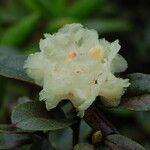Small shrubs, often prostrate or decumbent, (0.3–)0.5–1 (–1.5) m tall; branchlets loose, intricate, scaly, sparsely setose; bud scales deciduous. Petiole 3–8 mm, scaly; leaf blade aromatic, obovate-elliptic, ovate, rarely orbicular, (1.5–)2.5–3.5 (–4) × 1–1.6(–2.5) cm; base rounded; apex obtuse or rounded, mucronate; abaxial surface scales overlapping, dark reddish brown and dark yellow-brown, arranged in 2–3 tiers, often those of the lowest tier darker than rest; adaxial surface dark green, shiny, usually sparsely scaly. Inflorescence 4–6(–9)-flowered. Pedicel 0.2–0.4 cm, scaly; calyx lobes 3–5(–6) mm, elliptic or oblong, persisting to enclose mature capsule, scaly, margin densely ciliate; corolla narrowly tubular-funnelform, pink, or yellowish white, tube 6–12 mm, outer surface not scaly; inner surface densely pilose; lobes spreading, 1.2–2 cm; stamens (5–)6–8(–10), included in corolla tube, filaments glabrous; ovary ca. 1 mm, scaly; style short, thick, straight, as long as ovary, glabrous. Capsule ovoid, 3–5 mm, scaly. Fl. Apr–Jun, fr. Jul–Aug.
More
A compact shrub. It grows about 30-90 cm high. It spreads 90 cm wide. The leaves have stalks. The leaves are oval and can have a sharp tip. The upper surface is slightly scaly and the lower surface is densely scaly. The leaves have an aroma when crushed. The flowers are yellow or red. They are tube shaped. The fruit is a capsule. It is oval and enclosed in a layer of the flower which remains.
Moist open slopes, hillsides, ledges of cliffs and in thickets, often covering large areas; at elevations from 3,000-4,500, occasionally to 5,000 metres.
More
It is a temperate plant. In Nepal it grows between 3300-4600 m altitude. It grows on open, moist hillsides. It suits hardiness zones 7-9.

